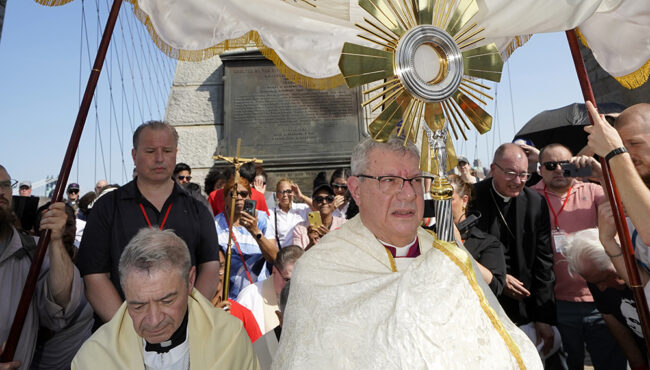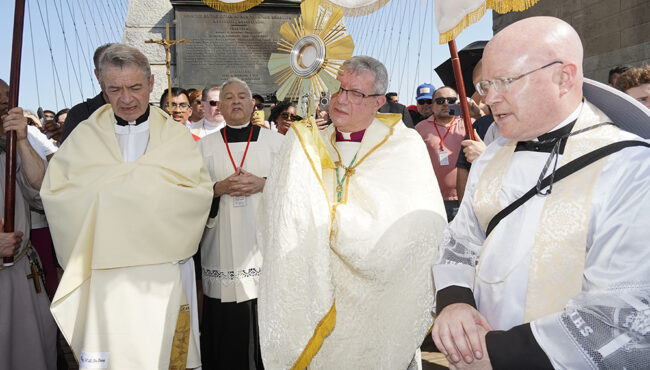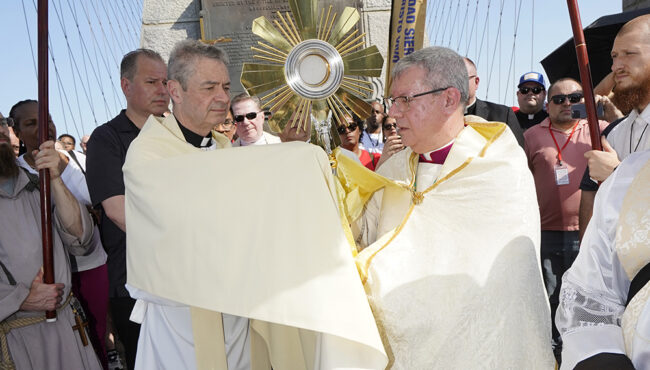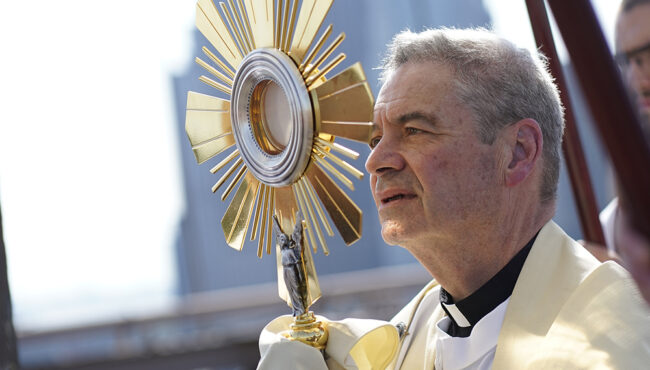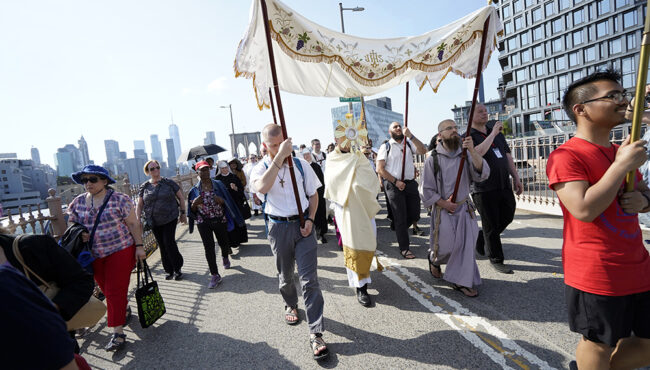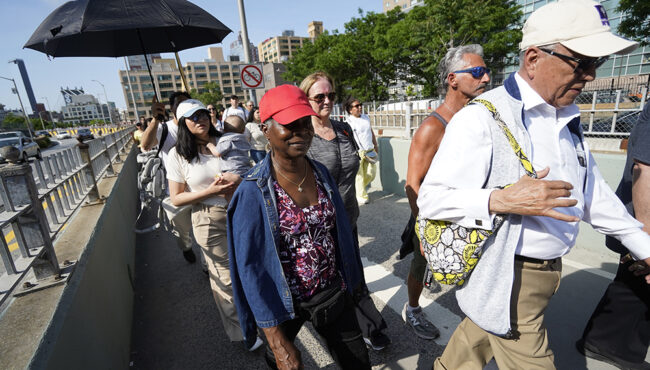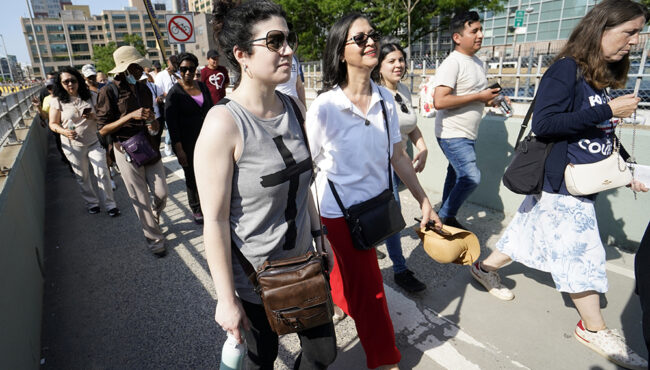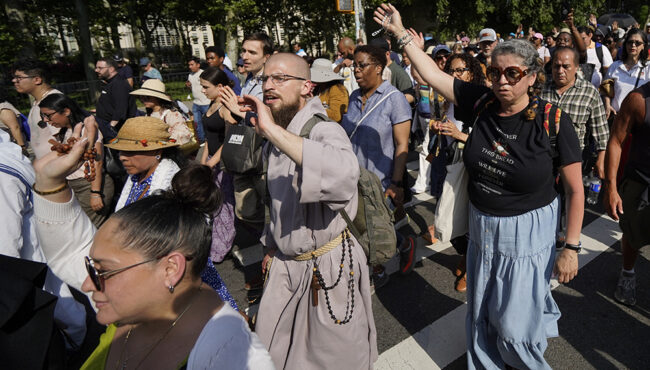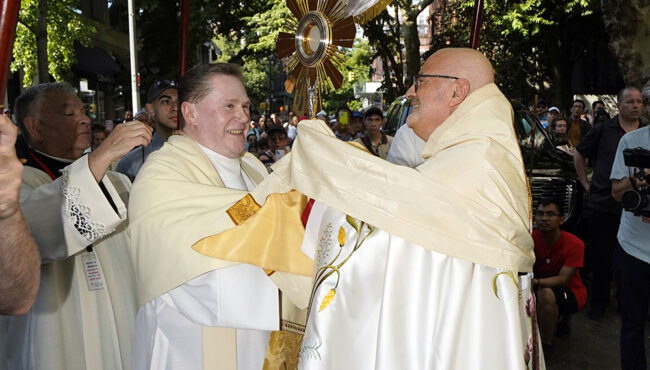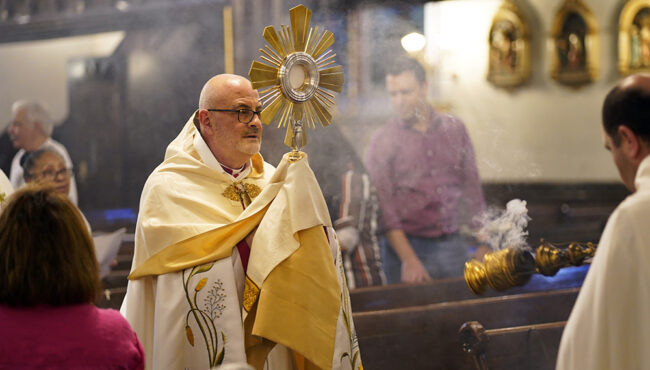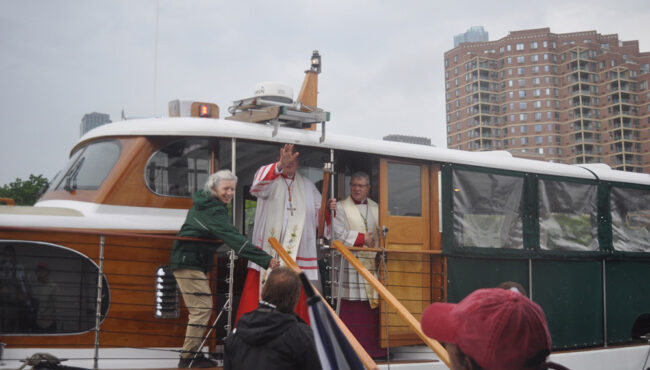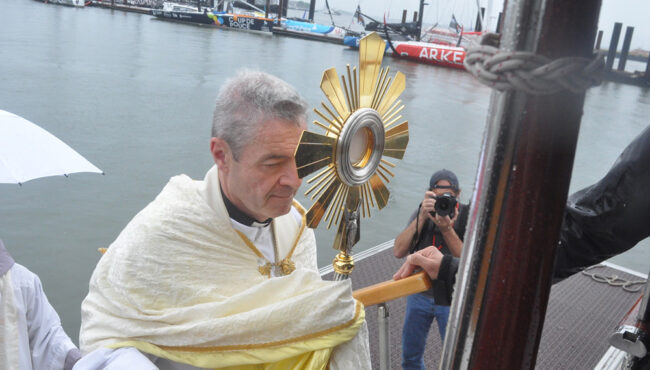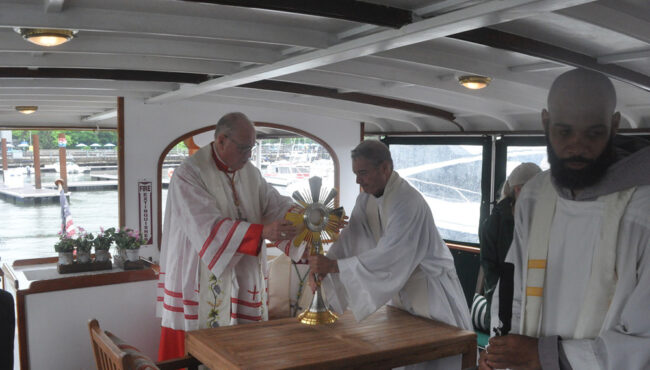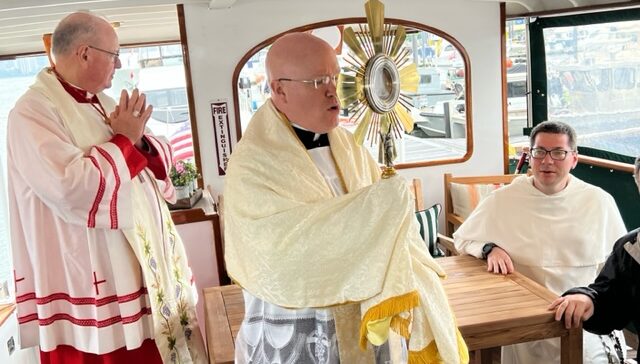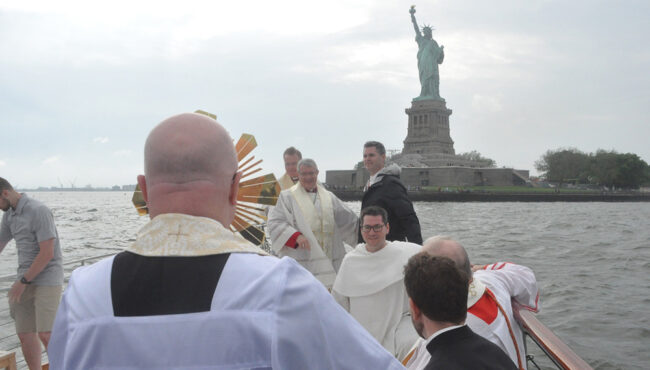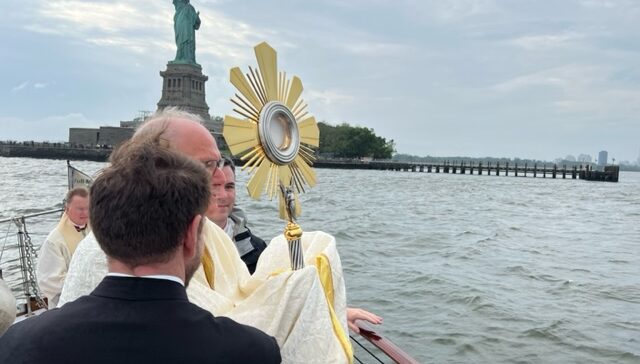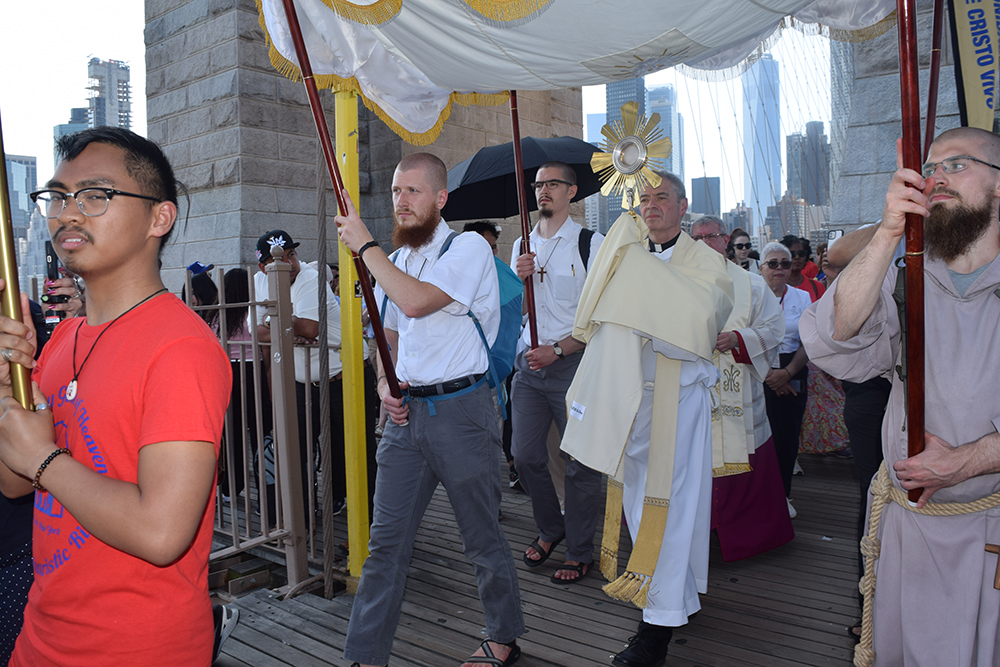
By John Lavenburg and Ed Wilkinson
PROSPECT HEIGHTS — Just after 4 p.m. on May 26, Bishop Robert Brennan looked from halfway along the Brooklyn Bridge toward Manhattan, where he saw a monstrance being carried under a canopy and a sea of thousands of faithful Catholics from the Archdiocese of New York coming toward him.
“It was a beautiful image to see the canopy and the monstrance, and also to see the people walking in the faith,” Bishop Brennan told The Tablet of that moment.
“The thought that came to mind was, every time we celebrate the Eucharist we meet Jesus, so it’s not as if He doesn’t come to us in the Eucharist every single day, but there was just something very vivid in welcoming Jesus to Brooklyn, welcoming Jesus among us and then carrying Jesus into Brooklyn.”
By 4:15 p.m., the monstrance and the thousands following behind it reached Bishop Brennan and the hundreds of faithful Catholics who had processed with him to the bridge. The monstrance was then handed off by Auxiliary Bishop Gerardo Colacicco to Bishop Brennan, who then led what grew to more than a thousand Catholics back into the Diocese of Brooklyn to continue the National Eucharistic Pilgrimage.
Among the thousands who participated in the day’s procession — which started in the Archdiocese of New York and ended at the Co-Cathedral of St. Joseph — were Catholics from the Archdiocese of New York, Diocese of Brooklyn, Diocese of Rockville Centre, and more. The Tablet even ran into a woman from Metuchen, New Jersey, who happened to be in the city and decided to join along.
Also in the crowd were the handful of perpetual pilgrims chosen by the National Eucharistic Revival to travel the entirety of the St. Elizabeth Ann Seton Route — the eastern route of the four National Eucharistic Pilgrimages making 6,500-mile journeys to Indianapolis. The Seton Route began in New Haven, Connecticut, on May 18, and after the weekend in New York City it continued to New Jersey on May 27.
After a full day in the Diocese of Brooklyn on May 27, the pilgrimage arrived at One15 Marina in Brooklyn, where Cardinal Timothy Dolan, New York Auxiliary Bishops Edmund Whalen and Gerardo Colacicco, the perpetual pilgrims, and others boarded a ship to bring the monstrance across the Hudson River to Jersey City.
The boat stopped at Liberty Island, where Cardinal Dolan raised the monstrance and blessed those standing beneath the Statue of Liberty. During the journey, the 20-or-so passengers on board sat around the Blessed Sacrament, prayed the rosary, sang songs, and prayed litanies.
On May 26, as the National Eucharistic Pilgrimage entered the Diocese of Brooklyn, Dominic Carstens, one of the Seton Route pilgrims who is actually from La Crosse, Wisconsin, told The Tablet it had been a great experience processing through the city, where there’s so many people to stop and get curious about what’s going on, and to join in from there.
“I grew up on a farm with trees and not in the urban jungle, but there’s so many people who are on the sidewalk and they look and they just hear the music and then they see the Lord and they’re just put in awe and stunned, and are curious,” Carstens said.
“It’s those sort of interactions that I’m going for — just for people to start to be curious about who our Lord is, who He is in the Eucharist, and from there they can build their own relationships with Him.”
Another pilgrim, Zoe Dongas, is from New York City. She told the Tablet that the experience on the pilgrimage so far, and the support they’ve gotten, “has been so wild.”
“Getting to walk through the Archdiocese of New York and now the Diocese of Brooklyn is just such a gift since this is my home,” Dongas said. “We’ve just received so much support from all of the dioceses coming out to praise the Lord.”
The day for Carstens, Dongas, and anyone else who joined them on their procession through the Big Apple began around 9:15 a.m. at St. Vincent Ferrer Catholic Church in the Upper East Side of Manhattan. From there, the pilgrims processed about a mile to St. Patrick’s Cathedral, in time for a 10:15 a.m. Mass celebrated by Cardinal Timothy Dolan.
The pilgrims, all dressed in black polo shirts, were seated on the cathedral’s altar. Cardinal Dolan greeted them following the Mass’ opening procession. He then, in pre-Mass remarks to the faithful, said the archdiocese was honored to host them.
In his homily, Cardinal Dolan then again said the archdiocese was “thrilled as we welcome pilgrims accompanying the Most Holy Eucharist on the national journey to the heartland in Indiana for our American Eucharistic Revival this coming July.”
There were more than 2,500 people present at the St. Patrick’s Cathedral Mass. Afterward, Cardinal Dolan led Benediction on the cathedral steps. Once the Benediction ended, the pilgrimage, with the monstrance out front, continued on to St. Peter’s Church in the Tribeca section of Lower Manhattan. More than a thousand people who attended the Mass at St. Patrick’s Cathedral participated in the procession.
Father Roger Landry, who is accompanying the Seton Route perpetual pilgrims on their journey, told The Tablet that there were more than 2,500 people who participated in the pilgrimage through Manhattan.
Once the monstrance was handed off to Bishop Brennan on the Brooklyn Bridge, the procession continued into Brooklyn, eventually going to Our Lady of Lebanon Maronite Cathedral in Brooklyn Heights, where a Benediction took place. While there, Bishop Gregory John Mansour of the Eparchy of Saint Maron of Brooklyn was handed the monstrance.
Bishop Mansour then brought the monstrance up the center aisle of the cathedral, and said he was shocked at the number of people he saw when he got to the altar and turned around.
“I thought there were about 40 or 50 [people],” Bishop Mansour told The Tablet. “When I turned around to bless there was a full church, and this church holds a thousand.”
Bishop Mansour said he was glad he and his church were invited and participated in the pilgrimage.
“It was a joy to see my brother bishops, to see priests, deacons, religious women and men, and lay faithful with deep devotion to God kneeling in tears, in reverence,” Bishop Mansour said.
“We truly believe after Ascension Thursday that this is how Jesus wanted us to meet him, in the breaking of the bread, and we’re doing it, and we are encountering the same Jesus that walked the earth here for 33 years.”
Walking with The Tablet as the pilgrimage moved back into Brooklyn, Bishop Brennan reflected on the significance of the National Eucharistic Pilgrimage, and its stop in New York City. He said it’s a reminder that “we’re a part of something much bigger than ourselves.”
“Here locally, these three dioceses coming together, we’re a part of something larger than ourselves,” Bishop Brennan said. “On the other hand we’re a part of something that’s happening nationally.”
“A procession that started elsewhere is going to Indianapolis and then three other processions are taking part around the country,” Bishop Brennan added. “We’re not alone. We’re not alone in our faith, but we’re never alone whenever we’re walking with the Lord.”
Throughout the entire day on May 26 as the pilgrimage made it through New York there was music. Much of it came from Dongas, who both sang and played guitar throughout. Carstens participated, as well, while also carrying a tall gray speaker so everyone could participate and hear.
They both said music is an essential part of their journey. Carstens even noted how he saw the way the music pulled someone off the sidewalk to join in on their journey.
“I met a man yesterday who was a musician himself, and the music is what first captivated him,” Carstens said.
“It hit his ears even before we could be seen. He heard us singing with joy and jubilation and it’s something that must have been great, that was his thought, and so as the music approached he approached as well to find and follow our Lord, and once he was there he saw the monstrance in its beautiful gold and that brought him right into Christ.”

